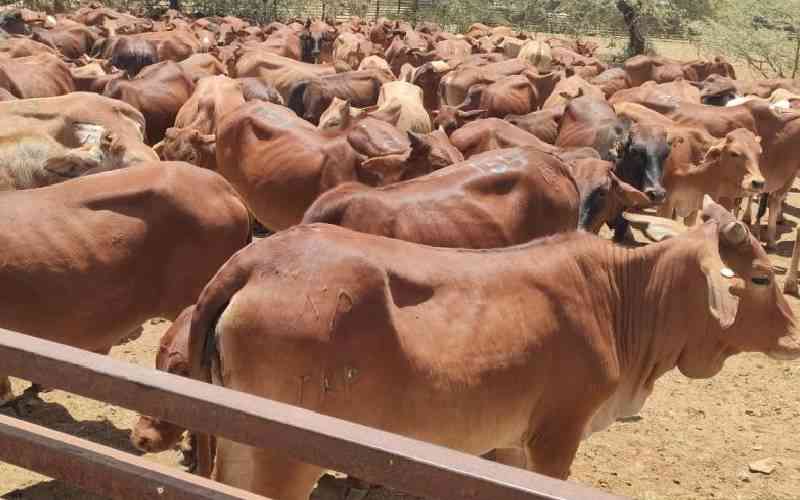Paul Ruto of Siriat Village, Sotik Constituency, Bomet County, led a ‘comfortable’ farmer’s life for years. He earned a net profit of Sh30,000 annually from maize he regularly planted on one acre of his land.
This situation would have remained so had the Maize Lethal Necrotic Disease (MLND) not struck the region three years ago.
“My maize crop was totally destroyed in 2012 and this forced me to think outside the box,” Ruto says.
He says that he researched on the Internet and decided to try fruit farming. He settled on passion fruits because of the market demand and the ease of establishment. He spent Sh7,000 for his first 350 seedlings that he bought from a farmer in Kericho and planted on a half an acre.
“When I planted the fruits, my neighbours could not comprehend how I was going to earn anything from kirindila (local name for passion fruit) but the benefits came in quick and some have now established their own,” Ruto says.
Ruto told ‘Smart Harvest’ that he picked the first fruits five months later and this went on for the next six months.
“Passion fruits are harvested every seven days and I earned Sh2,000 in the first month, but this increased gradually and by the third month I was getting Sh15,000. The fruits kept on increasing and my earnings finally peaked at Sh35,000 a month,” Ruto says.
High demand
When he saw the benefits of passion fruit farming, Ruto established another half-acre and this doubled his earnings to Sh70,000 every month. This is the net earnings after he has deducted the cost of production.
“Once the fruits are planted, the field practices are not expensive and I spend around Sh5,000 on fungicides, insecticides and labour every month,” Ruto says.
He says the crop has more advantages in that it is laden with fruit most of the year except for a period of around two months after pruning and new shoots have to grow. Therefore, a farmer has at least ten months to pick fruits in a year.
“I sell a kilo of passion fruit at an average of Sh100. This may go up to Sh140 when the demand is high,” he says.
Most of Ruto’s fruits are sold in markets around Kaplong, Sotik and Kapkatet and the vendors buy directly from his farm, thus, he does not spend on transport.
Passion fruits are grown in rows that are two metres apart while the crops are planted in holes three metres apart. A farmer is advised to grow the grafted seedlings that are available at Kenya Agriculture and Livestock Research Organisation and at other established farms and organisations that do grafting at small scale.
Ruto says that the holes should have enough manure before planting. He also advises farmers to plant the seedlings when there is enough water in the soil.
Stay informed. Subscribe to our newsletter
Passion fruits grow fast and the twines reach two metres in four months, thus a trailing wire should be set along the rows supported by strong poles. The wire will allow the fruit to hang making the management comfortable and hygienic.
After every season, Ruto prunes the fruits by cutting off the old branches so as to encourage new shoots to grow.
He says that passion fruits are susceptible to blight and stem end rot, and a farmer needs to use fungicides every two weeks to control these. He also advises farmers to apply insecticides every two weeks to discourage white flies and butterflies from nestling under the leaves.
Ruto is not stopping at this and he is planning to establish a nursery where he will be supplying seedlings to farmers very soon. He is also diversifying to tree-tomato and he already has 300 fruits in his farm.
 The Standard Group Plc is a
multi-media organization with investments in media platforms spanning newspaper
print operations, television, radio broadcasting, digital and online services. The
Standard Group is recognized as a leading multi-media house in Kenya with a key
influence in matters of national and international interest.
The Standard Group Plc is a
multi-media organization with investments in media platforms spanning newspaper
print operations, television, radio broadcasting, digital and online services. The
Standard Group is recognized as a leading multi-media house in Kenya with a key
influence in matters of national and international interest.
 The Standard Group Plc is a
multi-media organization with investments in media platforms spanning newspaper
print operations, television, radio broadcasting, digital and online services. The
Standard Group is recognized as a leading multi-media house in Kenya with a key
influence in matters of national and international interest.
The Standard Group Plc is a
multi-media organization with investments in media platforms spanning newspaper
print operations, television, radio broadcasting, digital and online services. The
Standard Group is recognized as a leading multi-media house in Kenya with a key
influence in matters of national and international interest.








